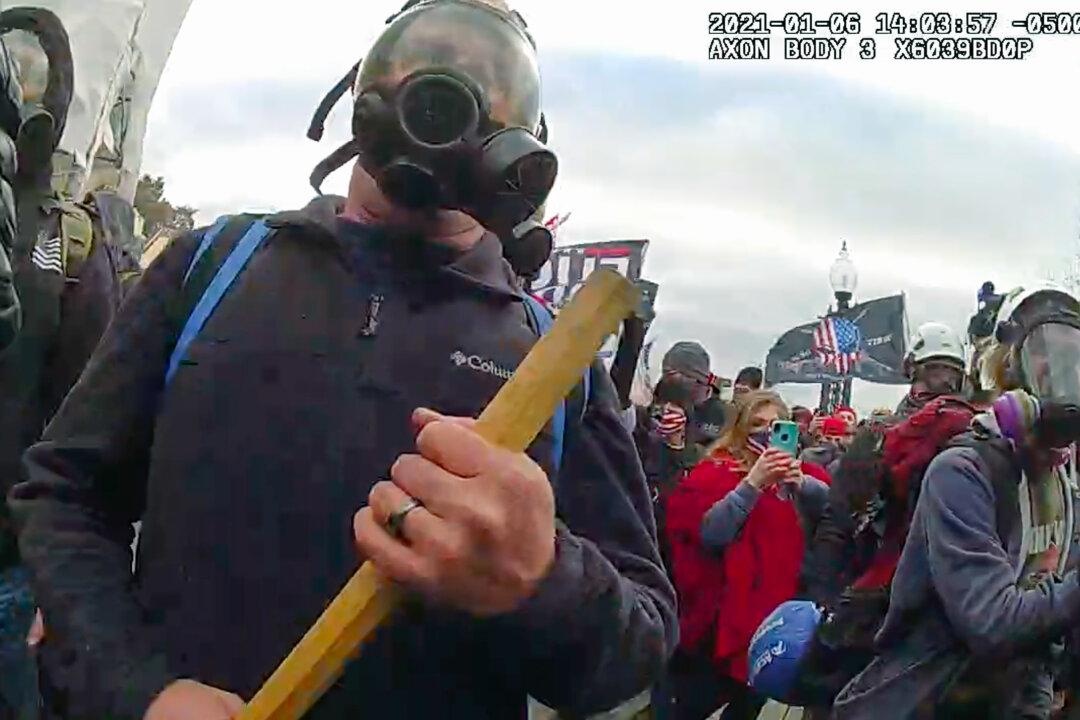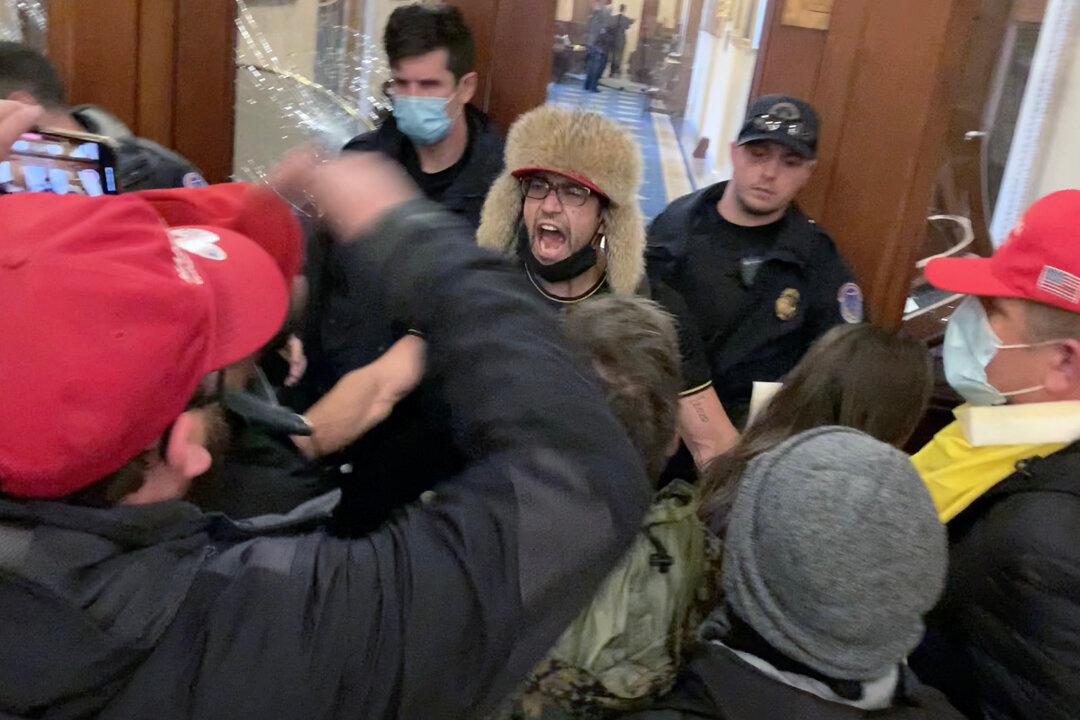“If she was your friend, you needed no other friend.”
That’s how Aaron Babbitt describes his wife, Ashli Babbitt, 35, the U.S. Air Force veteran shot and killed outside the House of Representatives at the U.S. Capitol on Jan. 6, 2021.
What started as a patriotic day with a speech by President Donald Trump ended with violence—none more brutal than the near-point-blank shooting of Ashli Babbitt.
Aaron Babbitt tells a favorite story about how his wife saw a woman running madly down the street one day, so she pulled her car over to see what was wrong.
“She pulled over: ‘Are you okay?’ ‘I’m late to a job interview,’” he recalls in a new documentary that shines new light on that fateful day and events that followed.
“Ashli brought that girl to her job interview and three days later, that woman came down to our office and gave her a hug and said, ‘I got that job and it’s ‘cause you got me there on time.’”
The interview with Babbitt is the most powerful moment in the 1 hour 38 minute “Capitol Punishment,” directed by Chris Burgard and produced by Nick Searcy. Babbitt recounts how he found out that his wife had been shot during rioting at the U.S. Capitol. He describes the pain of dealing with such an unimaginable loss.
“Hundred and forty seven days since my wife was murdered, executed,“ Babbitt said. ”Every day that goes by, it’s just another twist in the knife in my gut.”

The film’s opening segment shows Ashli Babbitt walking from Trump’s speech at the Ellipse to the U.S. Capitol.
“There’s an estimated over 3 million people here today,” she says in footage recorded with her phone. “So despite what the media tells you, boots on the ground definitely say different. There is a sea of nothing but red, white, and blue, and patriots and Trump.
“It was amazing to see the president talk. We are now walking down the inaugural path to the Capitol building.
“Three million plus people. God bless America, patriots.”
Two and a half hours later, she was dead.

Ashli Babbitt was shot in the upper left shoulder as she tried to climb through a smashed oval window in a door leading to the Speaker’s Lobby. As her head and shoulders emerged part way through the window, she was shot by Capitol Police Lt. Michael Byrd. The Washington D.C. medical examiner ruled her death a homicide. One week later, the U.S. Department of Justice decided not to bring charges against Byrd.
According to Searcy, the film’s focus on Babbitt is an effort to counter the scorn directed at her by the left.
“We wanted to humanize people, especially Ashli Babbitt,“ Searcy told The Epoch Times. ”She had been so vilified in the press and lied about, and her murderer was basically exonerated without even looking at what he did. So we wanted to humanize her and tell everybody this was not some crazed right-wing terrorist. This is a lovely woman who served her country for 11 years, signed up when she was 17. Very patriotic, somebody that you would be proud to live next to.”
“Capitol Punishment” challenges the dominant media narrative that a wild, lawless mob of Trump supporters tried to overthrow the U.S. government in a violent insurrection. The film makes a powerful statement—a dramatic telling of the Jan. 6 story from the perspective of the massive Trump contingent that came from every corner of the republic on Jan. 6.
Among the premises in “Capitol Punishment” is that the federal government played a central role in planning and directing the unrest. Government informants and as-yet-unidentified operatives set up the first breach of police lines, helped lay a trespassing trap for unsuspecting thousands of rally-goers who arrived later, and deftly instigated conflagrations of violence inside and outside the Capitol, the film alleges.
Embedded instigators pushed crowds inside the Capitol to move forward, the film says, using what one expert called “the kinetic power of humanity to overwhelm whatever police were still there.”
The film shows a well-known Black Lives Matter activist instigating and encouraging vandalism and violence at the double doors where Ashli Babbitt was shot just seconds later. Not long after, he’s seen in the Capitol rotunda, bragging about how he got the protesters to trash the door. His girlfriend replies, “You were right. We did it!”
It also shows an investigative journalist who tracked left-wing groups in online Zoom chats, discussing how to foment violence, smash windows, and breach the Capitol on Jan. 6. Some of the participants were federal employees.
Jan. 6 was not what the media and the federal government claim, Searcy said.
“In my view, it was an overwhelmingly peaceful protest by patriotic Americans that was turned into a violent event by evil instigators, both from the FBI and organizations like Antifa and BLM,” he said, referring to Black Lives Matter.
A Conservative in Hollywood
Searcy is well known by television audiences for his six-year run playing Deputy U.S. Marshal Art Mullen on the FX series “Justified.” He directed the 2018 film “Gosnell: The Trial of America’s Biggest Serial Killer.” He appeared in dozens of television series, including “Chicago Med,” “Hawaii Five-O,” “Intelligence,” “The Mentalist,” “Lie To Me,” “Without a Trace,” and “NCIS.”As one of the few visible conservatives in Hollywood, Searcy, 62, is used to speaking his mind in hostile territory. To adversaries, he’s brutally blunt, but he also has a keen wit and seemingly innate sense of humor that makes him a favorite—and a target—on social media.
Searcy said he hopes the documentary prompts conservatives not to be afraid to speak up about Jan. 6, showing the world—as the film’s tagline claims—“everything they told you is a lie.” “Capitol Punishment,” Searcy says, is all about truth and dramatic storytelling.

In a wide-ranging interview with The Epoch Times, Searcy did his best to disrupt the Jan. 6 narrative:
“Everybody I saw there was my age or older. What would we be armed with besides Poligrip and blood-pressure medicine and sleep apnea masks? The biggest lie is calling it an insurrection. They can ascribe the motives of 2 million people who went to Washington: ‘They were all racist white supremacist insurrectionists trying to overthrow the government.’ It’s a joke, really, it’s just a joke.”
“He was at the Capitol. He had gone over there before the speech ended. And they took down the signs that said ‘Restricted Area, Do Not Enter.’ They took down the fencing so that when people walked over from the Ellipse to the Capitol, they didn’t see anything that said ‘Restricted Area.’

“Couy Griffin talked about how they charged him with entering a restricted area and he said, ‘There were no signs. I didn’t see anything that said I couldn’t go in there.’ That’s because Ray Epps and the people that were working with him took those signs down so people would be trespassing without knowing it.”
“There’s a guy in the movie, Patrick Bergy, who talks about how they have this software that they can identify people that can be pushed through social media. And they can push people that are marginal, on either side. Whether they want to provoke people on BLM or if they want to provoke people that are Trump supporters or Proud Boys, they can find these marginal people and they can push them with social-media messages and get them to do violent things if they’re prone to do that.”

‘Deliberately Terrorizing These People’
The Epoch Times: What do you make of the tactics used by the FBI in sending heavily armed SWAT teams to arrest some of the Jan. 6 defendants?“So many of them, they lost their jobs. The Martinez family that was in the film, they lost their home. Easton Cantwell, the fellow from my hometown in North Carolina, he lost his business. They have intentionally destroyed these people’s lives simply for showing up there.”
[embed]https://youtu.be/B6dusvnhYWo[/embed]
“Most of these court-appointed attorneys are not working for their clients, they’re working for the government, trying to get plea deals, trying to get these people to plea to something so they can say, ‘See! We got another one, he admitted it.’ They want to target people that cannot fight them, that cannot fight back.”
“After that, as we started talking to these people who’ve been persecuted by the FBI. The stories about having their doors broken down and being treated like serial killers or drug cartel leaders. I couldn’t believe that. The first time I heard that, I was like, ‘You’ve got to be kidding.’ Then they showed me the Ring (doorbell) footage. They showed me the pictures. It’s shocking to me that this would happen in the United States of America. And even more shocking is that even people on the Democrat side are not as outraged as I am.”
“That’s how they treated me in Hollywood all these years. They try to make it seem like if you’re a Republican, you better keep your mouth shut. Even my own agents have said that. And I‘d say to them, ’No, I’m not going to keep my mouth shut.' I’m going to say what I know to be true, and I’m not going to let these people shut me up.”





